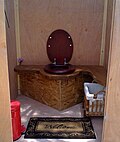Dry toilet
Dry toilet is a type of toilet system that operates without the use of water for flushing. Instead, it relies on the separation and containment of human waste to manage and process excreta. Dry toilets are an essential component of sustainable sanitation solutions, especially in areas where water is scarce, or where access to water-based sewage systems is limited. They play a crucial role in reducing water pollution and conserving water resources.
Types of Dry Toilets
There are several types of dry toilets, each with its unique method of managing waste. The most common types include:
- Composting toilets: These toilets convert human excreta into compost through the process of aerobic decomposition. They are equipped with a ventilation system to aid the composting process and to minimize odors.
- Urine-diverting dry toilets (UDDTs): UDDTs separate urine from feces at the point of use. This separation facilitates the hygienic recycling of nutrients and reduces the potential for disease transmission.
- Pit latrines: Although not all pit latrines are considered dry toilets, those that do not use water for flushing fall into this category. They are the simplest form of dry toilets, consisting of a hole in the ground with a slab or seat above it.
Benefits
Dry toilets offer several environmental and health benefits, including:
- Water conservation: By eliminating the need for water to flush, dry toilets significantly reduce water usage.
- Nutrient recycling: Nutrients from human waste, particularly in urine, can be safely recycled and used as fertilizer in agriculture, promoting soil health.
- Disease prevention: Properly managed dry toilets can help prevent the contamination of water sources with pathogens from human waste, thereby reducing the incidence of waterborne diseases.
- Sustainability: Dry toilets are often more sustainable than conventional water-based toilets, as they require less infrastructure and energy to operate.
Challenges
Despite their benefits, the implementation and acceptance of dry toilets face several challenges:
- Cultural acceptance: In many cultures, the concept of reusing human excreta, even as compost, is not readily accepted.
- Maintenance: Dry toilets require regular maintenance to manage waste and prevent odors, which can be a barrier to their adoption.
- Regulatory hurdles: In some regions, regulations and building codes are not adapted to accommodate dry toilet systems, hindering their implementation.
Conclusion
Dry toilets represent a viable alternative to traditional water-flushed toilets, offering significant environmental and health benefits. As the world continues to face water scarcity and sanitation challenges, the adoption of dry toilets could play a crucial role in promoting sustainable sanitation practices. However, overcoming cultural, maintenance, and regulatory barriers is essential for their wider acceptance and implementation.
Transform your life with W8MD's budget GLP-1 injections from $125.
W8MD offers a medical weight loss program to lose weight in Philadelphia. Our physician-supervised medical weight loss provides:
- Most insurances accepted or discounted self-pay rates. We will obtain insurance prior authorizations if needed.
- Generic GLP1 weight loss injections from $125 for the starting dose.
- Also offer prescription weight loss medications including Phentermine, Qsymia, Diethylpropion, Contrave etc.
NYC weight loss doctor appointments
Start your NYC weight loss journey today at our NYC medical weight loss and Philadelphia medical weight loss clinics.
- Call 718-946-5500 to lose weight in NYC or for medical weight loss in Philadelphia 215-676-2334.
- Tags:NYC medical weight loss, Philadelphia lose weight Zepbound NYC, Budget GLP1 weight loss injections, Wegovy Philadelphia, Wegovy NYC, Philadelphia medical weight loss, Brookly weight loss and Wegovy NYC
|
WikiMD's Wellness Encyclopedia |
| Let Food Be Thy Medicine Medicine Thy Food - Hippocrates |
Medical Disclaimer: WikiMD is not a substitute for professional medical advice. The information on WikiMD is provided as an information resource only, may be incorrect, outdated or misleading, and is not to be used or relied on for any diagnostic or treatment purposes. Please consult your health care provider before making any healthcare decisions or for guidance about a specific medical condition. WikiMD expressly disclaims responsibility, and shall have no liability, for any damages, loss, injury, or liability whatsoever suffered as a result of your reliance on the information contained in this site. By visiting this site you agree to the foregoing terms and conditions, which may from time to time be changed or supplemented by WikiMD. If you do not agree to the foregoing terms and conditions, you should not enter or use this site. See full disclaimer.
Credits:Most images are courtesy of Wikimedia commons, and templates, categories Wikipedia, licensed under CC BY SA or similar.
Contributors: Prab R. Tumpati, MD










